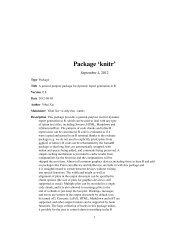Package 'openair'
Package 'openair'
Package 'openair'
You also want an ePaper? Increase the reach of your titles
YUMPU automatically turns print PDFs into web optimized ePapers that Google loves.
66 importTrajlocalfor example.Used for testing purposes on a local file system.DetailsValueThis function imports pre-calculated back trajectories using the HYSPLIT trajectory model (HybridSingle Particle Lagrangian Integrated Trajectory Model http://ready.arl.noaa.gov/HYSPLIT.php). Back trajectories provide some very useful information for air quality data analysis. However,while they are commonly calculated by researchers it is generally difficult for them to be calculatedon a routine basis and used easily. In addition, the availability of back trajectories over several yearscan be very useful, but again difficult to calculate.Trajectories are run at 3-hour intervals and stored in yearly files (see below). The trajectories arestarted at ground-level (10m) and propagated backwards in time.These trajectories have been calculated using the Global NOAA-NCEP/NCAR reanalysis dataarchives. The global data are on a latitude-longitude grid (2.5 degree). Note that there are manydifferent meteorological data sets that can be used to run HYSPLIT e.g. including ECMWF data.However, in order to make it practicable to run and store trajectories for many years and sites,the NOAA-NCEP/NCAR reanalysis data is most useful. In addition, these archives are availablefor use widely, which is not the case for many other data sets e.g. ECMWF. HYSPLITcalculated trajectories based on archive data may be distributed without permission (see http://ready.arl.noaa.gov/HYSPLIT_agreement.php). For those wanting, for example, to considerhigher resolution meteorological data sets it may be better to run the trajectories separately.We are extremely grateful to NOAA for making HYSPLIT available to produce back trajectories inan open way. We ask that you cite HYSPLIT if used in published work.The files consist of the following information:date This is the arrival point time and is repeated the number of times equal to the length of theback trajectory — typically 96 hours (except early on in the file). It is this field that should beused to link with air quality data. See example below.receptor Receptor number, currently only 1.year The yearmonth Month 1-12day Day of the month 1-31hour Hour of the day 0-23 GMThour.inc Number of hours back in time 0 to -96.lat Latitude in decimal format.lon Longitude in decimal format.height Height of trajectory (m).pressure Pressure of trajectory (kPa).Returns a data frame with pre-calculated back trajectories.
















